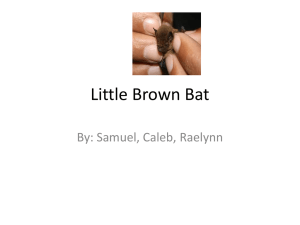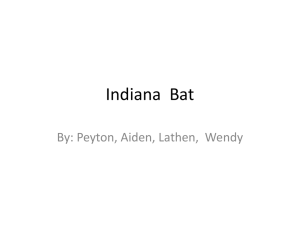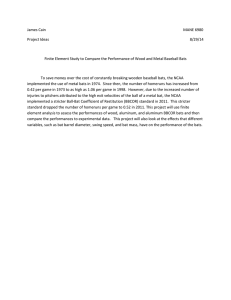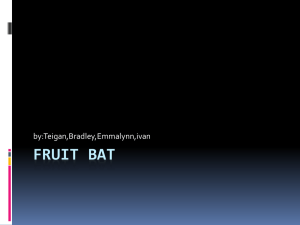Bats and the Law - Bat Conservation Trust
advertisement
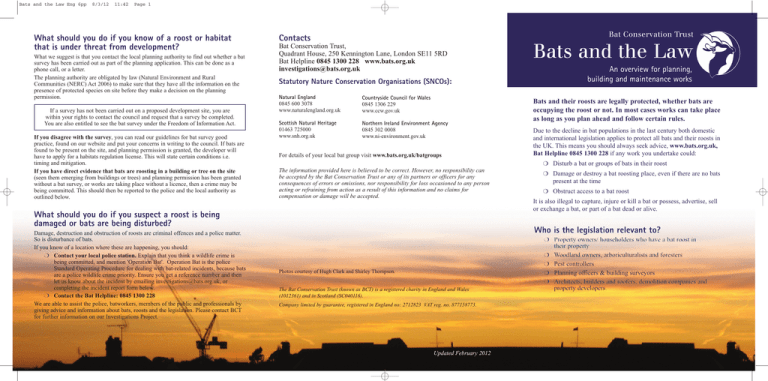
Bats and the Law Eng 6pp 8/3/12 11:42 Page 1 What should you do if you know of a roost or habitat that is under threat from development? What we suggest is that you contact the local planning authority to find out whether a bat survey has been carried out as part of the planning application. This can be done as a phone call, or a letter. The planning authority are obligated by law (Natural Environment and Rural Communities (NERC) Act 2006) to make sure that they have all the information on the presence of protected species on site before they make a decision on the planning permission. If a survey has not been carried out on a proposed development site, you are within your rights to contact the council and request that a survey be completed. You are also entitled to see the bat survey under the Freedom of Information Act. If you disagree with the survey, you can read our guidelines for bat survey good practice, found on our website and put your concerns in writing to the council. If bats are found to be present on the site, and planning permission is granted, the developer will have to apply for a habitats regulation license. This will state certain conditions i.e. timing and mitigation. If you have direct evidence that bats are roosting in a building or tree on the site (seen them emerging from buildings or trees) and planning permission has been granted without a bat survey, or works are taking place without a licence, then a crime may be being committed. This should then be reported to the police and the local authority as outlined below. Contacts Bat Conservation Trust, Quadrant House, 250 Kennington Lane, London SE11 5RD Bat Helpline 0845 1300 228 www.bats.org.uk investigations@bats.org.uk Statutory Nature Conservation Organisations (SNCOs): Natural England 0845 600 3078 www.naturalengland.org.uk Countryside Council for Wales 0845 1306 229 www.ccw.gov.uk Scottish Natural Heritage 01463 725000 www.snh.org.uk Northern Ireland Environment Agency 0845 302 0008 www.ni-environment.gov.uk For details of your local bat group visit www.bats.org.uk/batgroups An overview for planning, building and maintenance works Bats and their roosts are legally protected, whether bats are occupying the roost or not. In most cases works can take place as long as you plan ahead and follow certain rules. Due to the decline in bat populations in the last century both domestic and international legislation applies to protect all bats and their roosts in the UK. This means you should always seek advice, www.bats.org.uk, Bat Helpline 0845 1300 228 if any work you undertake could: ❍ Disturb a bat or groups of bats in their roost The information provided here is believed to be correct. However, no responsibility can be accepted by the Bat Conservation Trust or any of its partners or officers for any consequences of errors or omissions, nor responsibility for loss occasioned to any person acting or refraining from action as a result of this information and no claims for compensation or damage will be accepted. What should you do if you suspect a roost is being damaged or bats are being disturbed? Damage, destruction and obstruction of roosts are criminal offences and a police matter. So is disturbance of bats. If you know of a location where these are happening, you should: ❍ Contact your local police station. Explain that you think a wildlife crime is being committed, and mention 'Operation Bat'. Operation Bat is the police Standard Operating Procedure for dealing with bat-related incidents, because bats are a police wildlife crime priority. Ensure you get a reference number and then let us know about the incident by emailing investigations@bats.org.uk, or completing the incident report form below. ❍ Contact the Bat Helpline: 0845 1300 228 We are able to assist the police, batworkers, members of the public and professionals by giving advice and information about bats, roosts and the legislation. Please contact BCT for further information on our Investigations Project. Bats and the Law ❍ Damage or destroy a bat roosting place, even if there are no bats present at the time ❍ Obstruct access to a bat roost It is also illegal to capture, injure or kill a bat or possess, advertise, sell or exchange a bat, or part of a bat dead or alive. Who is the legislation relevant to? ❍ Property owners/ householders who have a bat roost in their property ❍ Woodland owners, arboriculturalists and foresters ❍ Pest controllers ❍ Planning officers & building surveyors Photos courtesy of Hugh Clark and Shirley Thompson. ❍ Architects, builders and roofers, demolition companies and The Bat Conservation Trust (known as BCT) is a registered charity in England and Wales (1012361) and in Scotland (SC040116). Company limited by guarantee, registered in England no: 2712823 VAT reg. no. 877158773. Updated February 2012 property developers. Bats and the Law Eng 6pp 8/3/12 11:42 Page 4 Bats and the law – An overview for planning, building and maintenance works Which legislation applies to bats and their roosts? Planning and Development In England and Wales, the relevant legislation is the Wildlife and Countryside Act (1981) (as amended); the Countryside and Rights of Way Act, 2000; the Natural Environment and Rural Communities Act (NERC, 2006); and by the Conservation of Habitats and Species Regulations (2010). In Scotland, the key legislation that applies is the Conservation (Natural Habitats &c.) Regulations 1994 (as amended). In Northern Ireland bats are listed under Schedule 2 of the Conservation (Natural Habitats etc) Regulations (Northern Ireland) 1995 and in the Republic of Ireland, under Schedule 5 of the Wildlife Act 1976 and Schedule 1 of the European Communities (Natural Habitats) Regulations 1997. The conservation of bats within the built environment is reliant on the delivery of a number of factors; ❍ the provision of roosting opportunities; ❍ the availability of foraging and commuting habitat; and ❍ the appropriate management and protection of existing roosts and areas For these to be delivered, development proposals must have as much information as possible before applications are given planning permission. Defences include: 1. Tending/caring for a bat solely for the purpose of restoring it to health and subsequent release 2. Mercy killing where there is no reasonable hope of recovery (provided that person did not cause the injury in the first place – in which case the illegal act has already taken place). Licensing Licenses to permit illegal activities relating to bats and their roost sites can be issued for specific purposes and by licensing authorities in each country. These are sometimes called ‘derogation licenses’ or ‘European Protected Species’ licenses, and are issued under the Habitats Regulations by a Statutory Nature Conservation Organisation. If you carry out work affecting bats or roosts without a license you will be breaking the law. Similarly it is an offence not to comply with the terms and conditions of a derogation license. Penalties on conviction – the maximum fine is £5,000 per incident or per bat (some roosts contain several hundred bats), up to six months in prison, and forfeiture of items used to commit the offence, e.g. vehicles, plant, machinery. Legal protection in the planning process Legislation dictates that any structures which bats use for shelter or protection are protected from damage or destruction whether occupied or not. This legislation has been incorporated into planning policies. This means that planning authorities have a legal obligation to consider whether bats are likely to be affected by a proposed development. How does this relate to day-to-day planning? ❍ If a bat survey has not already been undertaken to determine the potential for bats on site, and or the presence of bats: • The authority should request that the developers commission an appropriate survey. ❍ If a bat survey demonstrates that development is likely to affect bat foraging and/or commuting habitat: • Linear features such as tree lines should be retained, and compensatory planting should considered wherever possible. ❍ If a bat survey demonstrates that bats and/or a known roost are likely to be affected by the proposed development and planning permission is to be granted: • A condition should be placed on the decision notice requiring the developer to apply for, and obtain, a European Protected Species Licence before work commences. Steps to follow if bats are suspected at a building or development site 1. Contract an ecological consultant 2. Undertake a bat survey (at the appropriate time of year) 3. If bats are present, compile a mitigation plan/method statement to be shared with architects and/or building contractors 4. Incorporate the bat survey report and mitigation plan/method statement into planning application 5. Apply for planning permission 6. Apply for an European Protected Species license (if needed) 7. If granted, carry out works with ecologist supervision 8. Compliance check to ensure that mitigation is being properly implemented 9. Monitor the site to check response of the bat population to the mitigation Please consult the Bat Helpline 0845 1300 228 if you have any questions about this process.
